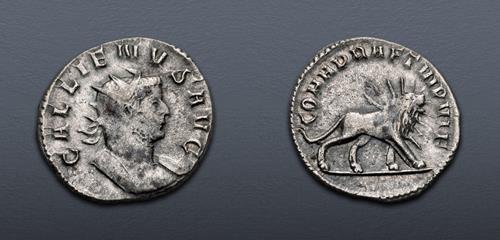|
Gallienus. AD 253-268. Antoninianus (20.5mm, 2.70 g, 12h). “Legionary series” issue. Mediolanum (Milan) mint. 2nd emission, AD 261. Radiate and cuirassed bust right / COHH PRAET VI P VI F, Radiate lion walking right. RIC V 370; MIR 36, 979n; Toffanin 69/3; RSC 105. Toned. VF.
From the Rome on the Euphrates Collection.
The extensive legionary series of coins struck by Gallienus commences with this issue, honoring the Praetorian Cohorts, the elite unit of soldiers stationed in a purpose-built fortress in Rome. Composed of nine enlarged cohorts of 1,000 men apiece, for a total theoretical strength of 9,000, the Praetorian “Guard” served as the emperor’s personal fighting force both in Rome and on campaign. Praetorians received triple the pay of ordinary soldiers and had to serve only 16 years instead of the 20 required for regular legionaries. They were consequently greatly resented both by the regular soldiery and by the civilians of Rome, who they were often called upon to suppress. Estimates of their fitness as a fighting force in the field vary; they seem to have accounted themselves well enough in the campaigns of Trajan, Marcus Aurelius and Septimius Severus, but when called upon to fight regular units in Rome’s numerous civil wars, they almost always suffered defeat. The Praetorians had two totemic symbols which appear on coins and monuments: A lion (seen here) and a scorpion, the latter being the birth sign of Tiberius, who built the first Praetorian camp.
The formulae V P V F, VI P VI F and VII P VII F, which appear on most of the Gallienus legionary issues, have been subject to numerous interpretations. Translated directly as ”five / six / seven times loyal, five / six / seven times dutiful” scholars of the past regarded it as recording an annual loyalty vow taken up by the legions, which would place these issues circa AD 257-259, during the joint reign with Valerian. It is now recognized that these coins were struck after Valerian’s defeat and capture, circa AD 260-261, apparently as part of a large payment to the soldiers to shore up their crumbling loyalty to Gallienus. The coins recognize the Praetorians and 17 legions; some of the units stationed in Gaul, Spain and Britain, which had rebelled against Gallienus, do not appear, while others do. This indicates that the “legions” being recognized were, in some cases, actually small detachments or “vexillations” of legions gathered together to form the large central field army assembled by Gallienus in Milan circa AD 259-261. Andreas Alföldi proposed in 1977 that the V / VI / VII P, V / VI / VII F legends celebrate the fifth, sixth and seventh victories won by the legions on behalf of Gallienus and the “legitimate” Roman regime, from the time of his accession in AD 253 to his early sole reign. The first four were victories over German tribes in AD 253-258; the fifth was his crucial defeat of the Alemanni in 259, the sixth was the suppression of the rebellion by Ingenuus in AD 260, and the seventh marked the defeat of another usurper, Regalianus, later that same year.
Closing Date and Time: 1 December 2021 at 12:44:00 ET.
All winning bids are subject to an 18% buyer’s fee.
|
